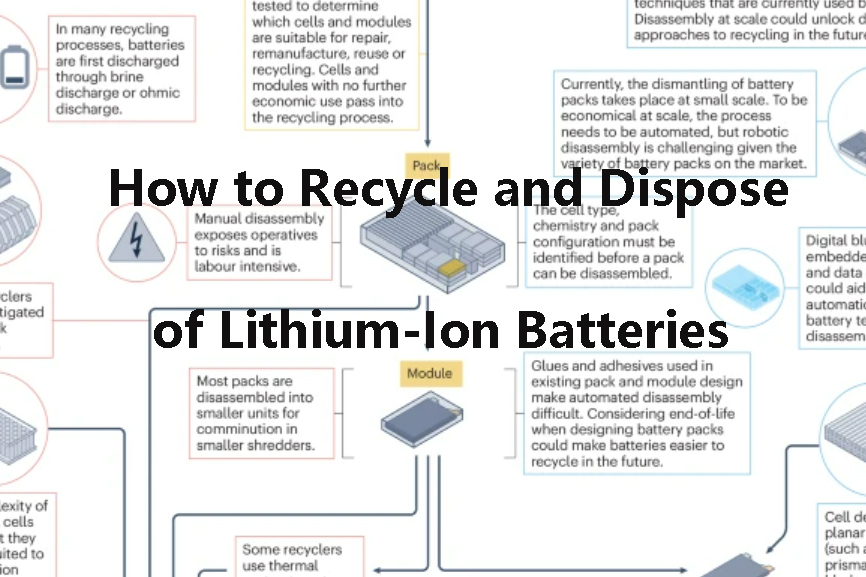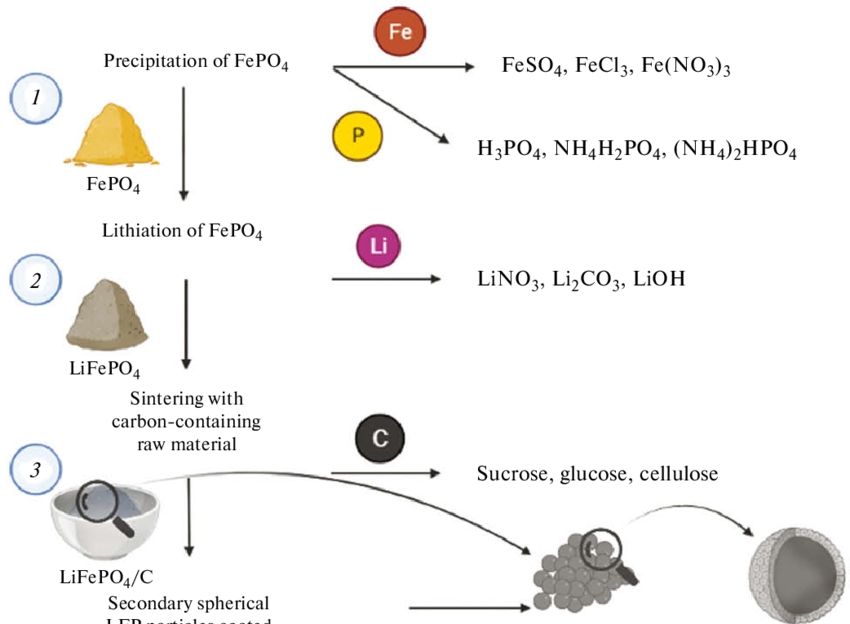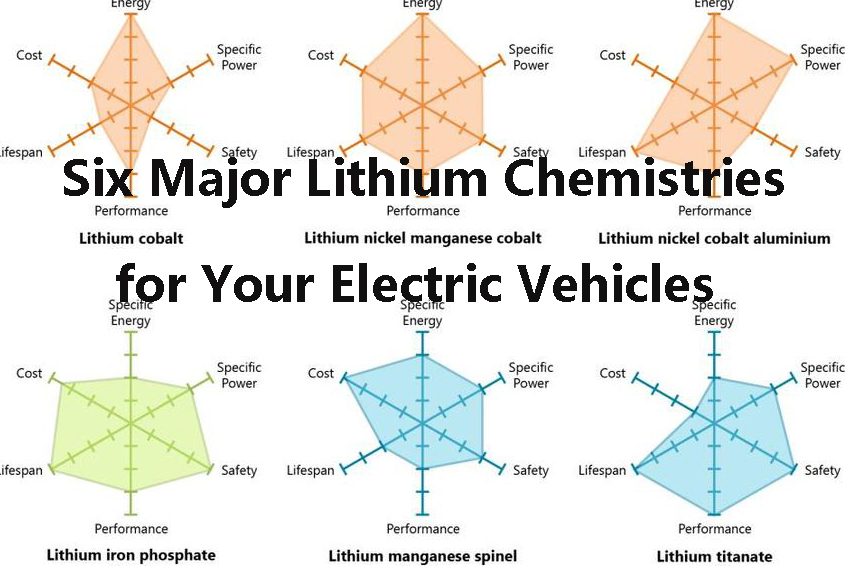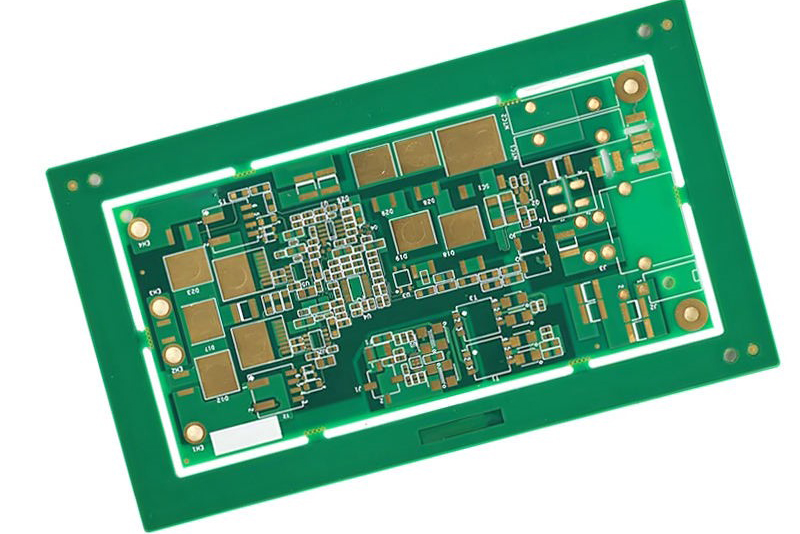
Essential Electronic Materials: Part 4 - Gallium Compounds
1. Introduction
Gallium-based compounds, including gallium oxide (Ga₂O₃), gallium arsenide (GaAs), and gallium nitride (GaN), have gained significant attention in the fields of electronics and semiconductors due to their exceptional physical and chemical properties. These materials exhibit a wide range of electrical, optical, and thermal characteristics, making them indispensable for advanced technologies.
- Gallium oxide (Ga₂O₃): Known for its ultra-wide bandgap and high breakdown electric field, Ga₂O₃ is emerging as a promising material for high-power electronics, ultraviolet (UV) photodetectors, and other optoelectronic applications.
- Gallium arsenide (GaAs): A direct bandgap semiconductor with superior electron mobility and high-frequency performance, GaAs has long been a cornerstone in optoelectronic devices such as lasers, LEDs, and photovoltaic cells.
- Gallium nitride (GaN): With its wide bandgap, high thermal conductivity, and excellent efficiency, GaN has revolutionized power electronics and high-frequency communication systems.
The synthesis techniques for these materials—ranging from chemical vapor deposition (CVD) and molecular beam epitaxy (MBE) to innovative hybrid processes—play a critical role in achieving the desired crystal quality and performance. As gallium compounds continue to drive advancements in power, optoelectronics, and sensing technologies, understanding their structure, properties, and applications has become vital for researchers and industry professionals alike.
This article provides a comprehensive overview of the structural characteristics, physical properties, fabrication methods, and applications of Ga₂O₃, GaAs, and GaN, highlighting their current advancements and future prospects in the rapidly evolving semiconductor landscape.
2. Gallium Oxide (Ga₂O₃)
Gallium oxide, with the chemical formula Ga₂O₃, is an inorganic compound and a wide-bandgap semiconductor (Eg = 4.9 eV). Its conductivity and luminescence properties have attracted significant attention. Ga₂O₃ is a transparent oxide semiconductor material with broad application prospects in optoelectronic devices, such as insulating layers in Ga-based semiconductors, UV filters, and O₂ chemical detectors.
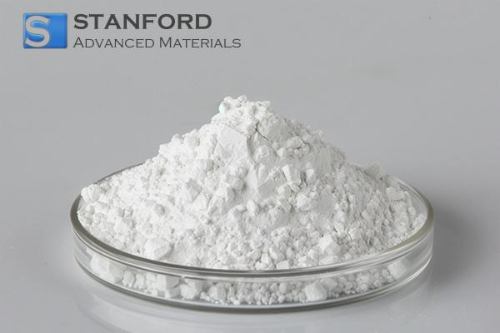
Fig. 1 Gallium Oxide Powder
2.1 Crystal Structure of Gallium Oxide
Ga₂O₃ exists in five primary crystal structures: β-Ga₂O₃, α-Ga₂O₃, γ-Ga₂O₃, δ-Ga₂O₃, and ε-Ga₂O₃.
- β-Ga₂O₃: Monoclinic crystal system with space group P21. It exhibits high electron mobility, a wide direct energy gap, and good thermal stability. Applications include high-power semiconductor devices and deep-ultraviolet optoelectronic devices.
- α-Ga₂O₃: Tetragonal crystal system with space group C4V. It is an excellent optical material with high light transmittance and corrosion resistance, used in optoelectronics and communications.
- γ-Ga₂O₃: Cubic crystal system with space group Ia3. It has high optical transmittance, low defect density, and high magnetic permeability, making it suitable for magneto-optical and UV detector devices.
- δ-Ga₂O₃: Orthorhombic crystal system with space group Pnma. It has a high bandgap, excellent photovoltaic properties, and good physicochemical stability.
- ε-Ga₂O₃: Trigonal crystal system with space group R3c. It exhibits high carrier mobility, thermal stability, and UV response properties, making it suitable for UV detectors and power electronics.
Table 1: Comparison of Different Ga₂O₃ Structures
|
|
β-Ga2O3 |
α-Ga2O3 |
γ-Ga2O3 |
δ-Ga2O3 |
ε-Ga2O3 |
|
Crystal Structure |
Monoclinic Crystal System |
Tetragonal Crystal System |
Cubic Crystal System |
Orthogonal Crystal System |
Tripartite Crystal System |
|
Space Group |
P21 |
C4V |
Ia3 |
Pnma |
R3c |
|
Cell Parameters |
a=12.203 b=5.671 c=6.524 β=105.76 |
a=12.22 c=5.86 |
a=13.54 |
a=7.794 b=5.580 c=5.395 |
a=7.794 b=5.580 c=5.395 |
|
Properties |
High electron mobility |
High light transmittance |
High optical transmittance |
High bandgap |
High carrier mobility |
|
Wide direct energy gap |
Good corrosion resistance |
Low defect density |
Excellent optoelectronic properties |
High thermal stability of the material |
|
|
Good thermal stability |
- |
High magnetic permeability |
Good physicochemical stability |
Good UV response characteristics |
|
|
Applications |
High-power semiconductor devices and deep-ultraviolet optoelectronic devices |
Optoelectronics and optoelectronic communications |
Potential use in magneto-optical devices and UV detector devices |
- |
Ultraviolet detectors, power electronics |
2.2 Physical and Chemical Properties of Ga₂O₃
- Chemical Reactions: Ga₂O₃ reacts with fluorine gas to produce GaF₃ and dissolves in dilute acids. It is insoluble in concentrated acids or strong bases unless melted with NaOH or KOH.
- Thermal Stability: Ga₂O₃ reacts with metal oxides to form gallates, which are used in lasers, phosphors, and luminescent materials.
- Semiconductor Properties: Ga₂O₃ has an ultra-wide bandgap, high breakdown electric field strength, and low on-resistance, making it ideal for high-power and high-temperature applications.
2.3 Preparation of Ga₂O₃
1. Direct Reduction Method: Involves reacting nitrogen with gallium metal to form gallium nitride, which is then oxidized to Ga₂O₃.
2. Chemical Vapor Deposition (CVD): Uses gaseous precursors like GaCl₃ to produce high-purity Ga₂O₃.
3. Acid Method: Involves oxidation, neutralization, filtration, washing, drying, roasting, grinding, and packaging.
2.4 Applications of Ga₂O₃
1. Power Electronics: Ga₂O₃'s high breakdown electric field and low on-resistance make it suitable for high-voltage and high-power devices, such as motor drives and smart grid systems.
2. Optoelectronic Devices: Used in UV detectors and deep-UV LEDs for environmental monitoring, sterilization, and semiconductor manufacturing.
3. Sensors: Ga₂O₃ is used in humidity, temperature, gas, and pressure sensors due to its chemical and electrical properties.
4. Other Applications: Includes flexible displays, battery materials, and radio-frequency applications like radar systems and satellite communications.
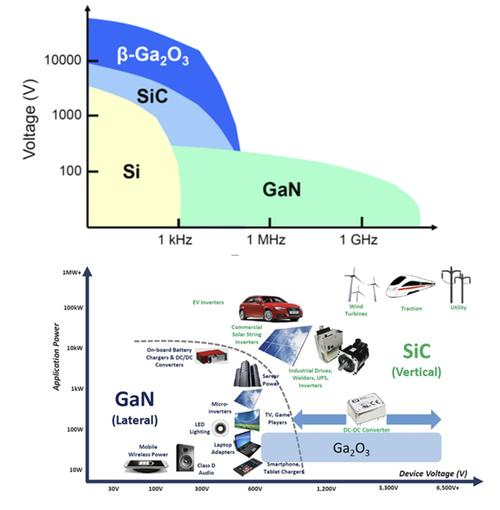
Fig. 2 Comparison of Applications of SiC, GaN and Ga2O3
3. Gallium Arsenide (GaAs)
Gallium arsenide, with the chemical formula GaAs, is a black-gray solid with a melting point of 1,238°C. It is a III-V compound semiconductor with a sphalerite-type lattice structure and a bandgap of 1.4 eV.
3.1 Crystal Structure of GaAs
GaAs has a face-centered cubic (FCC) structure, with Ga atoms at the lattice vertices and As atoms at the face centers. The lattice constant is a = 5.6535 Å.
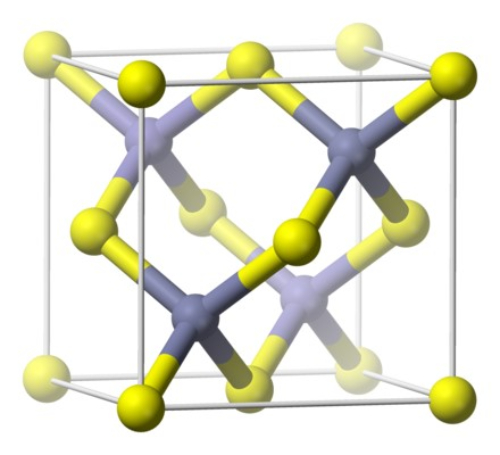
Fig. 3 Crystal Structure of Gallium Arsenide
3.2 Physical and Chemical Properties of GaAs
- Electronic Properties: GaAs has higher electron mobility and saturation velocity than silicon, making it suitable for high-frequency and low-noise applications.
- Thermal Stability: GaAs is stable in air below 600°C and resistant to non-oxidizing acids.
Table 2: Physical Properties of GaAs
|
Density |
5.31g/cm3 |
|
Melting Point |
1238℃ |
|
Refraction Index |
3.57 |
|
Relative Permittivity |
13.18 |
|
Electron Affinity Energy |
4.07eV |
|
Lattice Energy |
5.65×10-10m |
|
Band Gap |
1.424e(300K) |
|
Electron Mobility |
8500cm2/(V·s)(300K) |
|
Appearance |
Black-Grey Solid |
3.3 Preparation of GaAs
1. Vertical Gradient Solidification (VGF): Produces high-quality GaAs crystals.
2. Liquid Encapsulation Pulling Method (LEC): Used for semi-insulating GaAs crystals.
3. Horizontal Bridgman Method (HB): Suitable for low-dislocation-density crystals.
4. Chemical Vapor Deposition (CVD): Produces high-purity GaAs thin films.
3.4 Applications of GaAs
1. Microwave Field: Used in high-frequency devices like HEMTs and LEMTs for wireless communications and radar systems.
2. Optoelectronics: GaAs is used in lasers, LEDs, and solar cells due to its direct bandgap.
3. Communication: Used in fiber optic communication devices like optical receivers and amplifiers.
4. Solar Cells: GaAs solar cells offer high efficiency and stability.
5. Microelectronics: Used in high-speed circuits, flash memory, and power transistors.
4. Gallium Nitride (GaN)
Gallium nitride, with the chemical formula GaN, is a third-generation semiconductor material known for its wide bandgap, high thermal conductivity, and chemical stability.
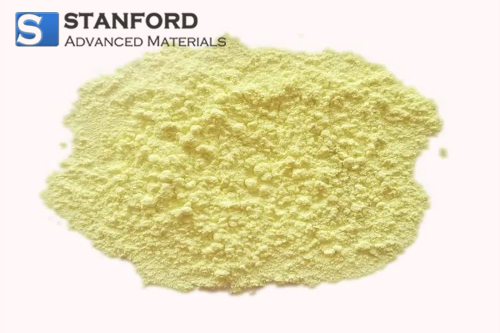
Fig. 4 Gallium Nitride Powder
4.1 Crystal Structure of GaN
GaN has a hexagonal wurtzite structure, with each Ga atom bonded to four N atoms. The lattice constant is a = 3.189 Å and c = 5.185 Å.
4.2 Properties of GaN
- Energy Gap: 3.4 eV, enabling high transparency in the visible spectrum.
- Mechanical Properties: High hardness and modulus of elasticity.
- Thermal Properties: Excellent thermal conductivity and low thermal expansion.
- Optical Properties: High transparency and low absorption in the visible region.
- Chemical Stability: Resistant to acids, alkalis, and oxidation.
- Electronic Performance: High electron mobility and saturation drift velocity.
4.3 Preparation of GaN
GaN is typically grown using MOCVD, MBE, or HVPE techniques. The reaction involves the decomposition of TMGa and NH₃ at high temperatures.
4.4 Applications of GaN
1. Power Electronics: GaN is used in high-power and high-frequency devices like HEMTs and MOSFETs.
2. Optoelectronics: GaN is the material of choice for blue and green LEDs, lasers, and UV detectors.
3. Sensors: GaN is used in pressure, temperature, gas, and optical sensors due to its stability and sensitivity.
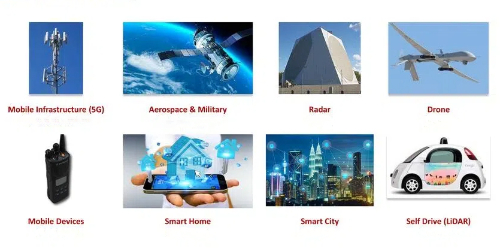
Fig. 5 Applications of Gallium Nitride
5. Conclusion
Gallium-based compounds, including Ga₂O₃, GaAs, and GaN, are at the forefront of modern semiconductor technology. Each material offers unique advantages:
- Ga₂O₃: High-power and high-voltage applications.
- GaAs: High-speed and optoelectronic devices.
- GaN: Power electronics and high-frequency communication systems.
Advanced synthesis techniques like CVD and MBE have enabled precise control over material quality, driving innovation across industries. From power conversion and UV detection to 5G communication and renewable energy, gallium compounds are addressing the demand for energy-efficient, high-performance devices.
As research continues, these materials are expected to overcome challenges like thermal management and scalability, further expanding their applications in electronics, optoelectronics, and beyond.
Stanford Electronics is a leading provider of high-quality gallium materials, supporting these critical applications with reliable material solutions.
Further Reading:
Essential Electronic Materials: Part 1 - Silicon

